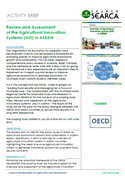Review and Assessment of the Agricultural Innovation Systems (AIS) in ASEAN
20 July 2015 – 10 April 2016
Background
 The Organisation for Economic Co-Operation and Development (OECD) had been strengthening its cooperation with the ASEAN particularly in the area of food, agriculture, and related policies. In consultation with ASEAN, it had initiated a project entitled "Building food security and managing risk: A focus on Southeast Asia," aimed at identifying policy issues to improve agriculture productivity growth and sustainability in ASEAN region. A component of this project initiative was the conduct of a brief stocktaking of agricultural innovation systems in the ASEAN region and an assessment of the cross-country technology transfer systems within the region. The OECD commissioned the Southeast Asian Regional Center for Graduate Study and Research in Agriculture (SEARCA) to undertake the stocktaking, which involved a checklist of agricultural innovation systems in place within ASEAN countries based on the analytical framework prescribed by the OECD.
The Organisation for Economic Co-Operation and Development (OECD) had been strengthening its cooperation with the ASEAN particularly in the area of food, agriculture, and related policies. In consultation with ASEAN, it had initiated a project entitled "Building food security and managing risk: A focus on Southeast Asia," aimed at identifying policy issues to improve agriculture productivity growth and sustainability in ASEAN region. A component of this project initiative was the conduct of a brief stocktaking of agricultural innovation systems in the ASEAN region and an assessment of the cross-country technology transfer systems within the region. The OECD commissioned the Southeast Asian Regional Center for Graduate Study and Research in Agriculture (SEARCA) to undertake the stocktaking, which involved a checklist of agricultural innovation systems in place within ASEAN countries based on the analytical framework prescribed by the OECD.
Objectives
The project aimed to identify the policy issues to improve agricultural productivity growth and sustainability in ASEAN region. Specifically, it aimed to provide an overview and conduct an assessment of agricultural innovation system in ASEAN countries, highlighting the need to evolve agricultural innovation system to generate innovative solutions for long-term food security concerns.
Methodology
Following the analytical framework of the OECD Secretariat, the scoping study included a report on the overview and assessment of the agricultural innovation system in ASEAN countries as well as qualitative and quantitative information on the role of the government in agricultural agro-food innovation. The report was based on all sources of data and literature available covering four major topics of national agricultural innovation system, namely: (1) governance of innovation system, (2) investments in innovation, (3) facilitating knowledge flow, and (4) strengthening cross-country supply of agricultural innovation. A survey questionnaire was administered among representatives of the ASEAN Member States (AMS) participating in the consultation seminars co-organized by the OECD and the ASEAN Secretariat to assess agricultural innovation systems' strengths, weaknesses, and information gaps.
The preliminary report was presented by SEARCA during the OECD-ASEAN Regional Conference on Agricultural Policies to Promote Food Security and Agro-Forestry Productivity on 12-13 October 2015 in Seoul, South Korea. The draft final report was discussed during the OECD-FAO-ASEAN Regional Conference on Policies to Enable Food Security, Agricultural Productivity and Improved Nutrition on 14-15 June 2016 at Nay Pyi Taw, Myanmar.
Summary of Results
The study confirms the fragmentation in the governance structure for agricultural innovation systems within the ASEAN region. However, it has documented the valuable experiences of a number of AMS that have seriously grappled with this challenge. Agricultural innovation system is a new and emerging concept for many AMS. Its successful adoption will certainly require the commitment and support not only from agriculture ministries but more importantly from the highest government leadership and other ministries that also handle issues on agriculture research and innovation.
In most AMS, government has been and continues to be the predominant funder of agricultural R&D. However, some governments are beginning to seriously consider more innovative funding mechanisms.
The need to transform public and private extension and advisory services as well as agricultural education and training to a more demand-driven system is well recognized as a key to facilitate network based setting of knowledge flows. However, public funding remains limited.
There are a number of existing networks, consortia, and platforms in the ASEAN that can be possibly tapped not only for cross-border technology transfer but also for promoting participation of the AMS in addressing transnational innovation issues.